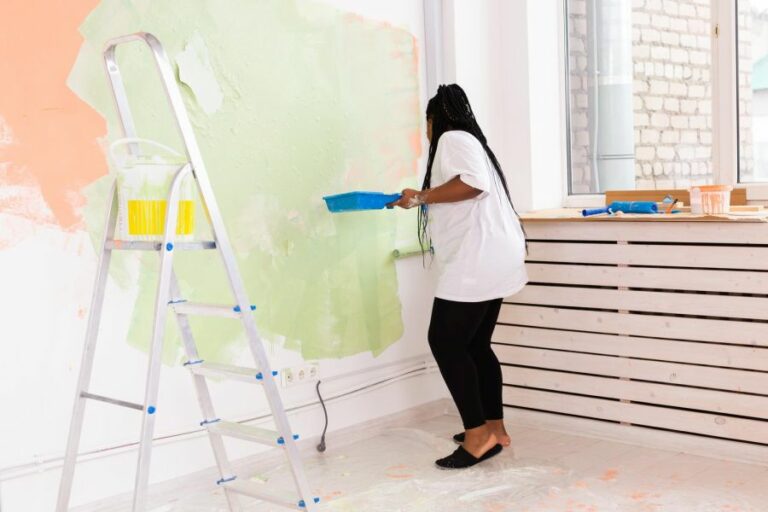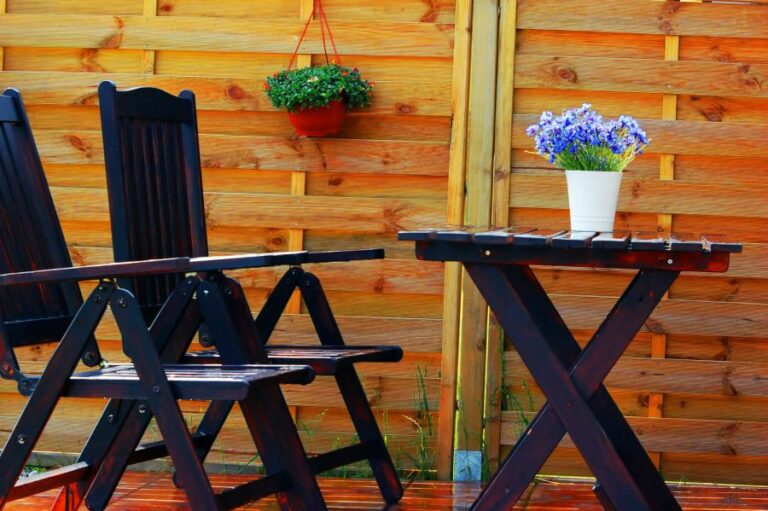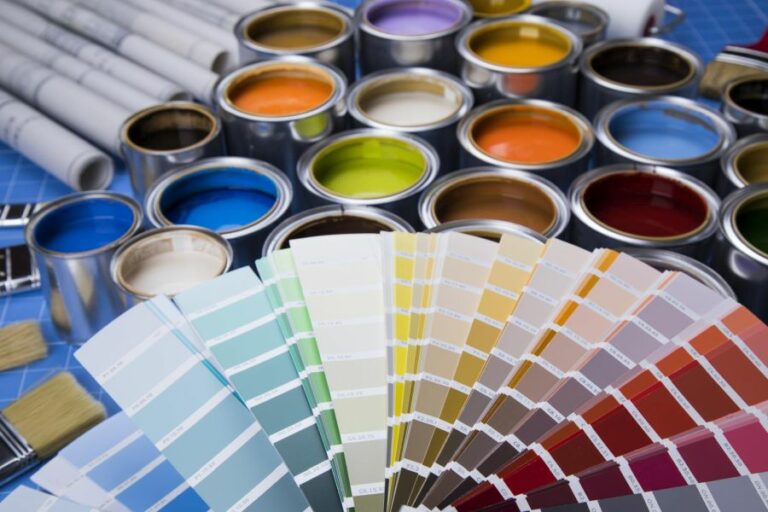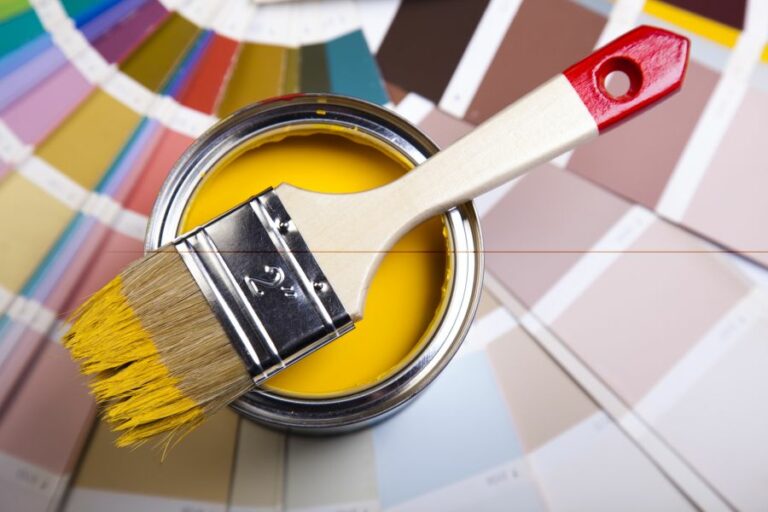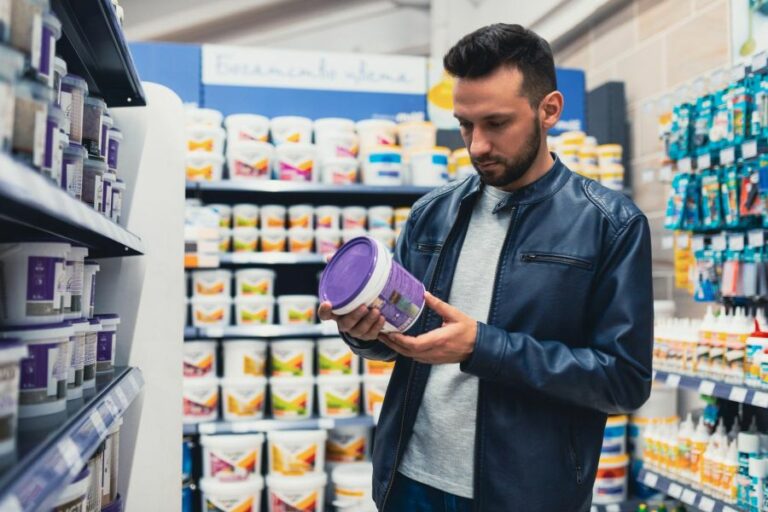Bring Compassion to Your Home with Outdoor Paint Colors
Are you ready to revamp your home’s exterior and give it a makeover? Choosing the perfect outdoor paint color can transform your house’s curb appeal and make it the envy of your neighbors! Let’s explore the world of outdoor paint hues, expert tips, trending options, and must-know do’s and don’ts.
Outdoor paint color:
Choosing the right outdoor paint color can greatly enhance curb appeal and add value to your home. Consider factors like your home’s architectural style, surrounding landscape, and climate when selecting a color. Popular schemes include earthy tones, bold colors, or classic white with accents. Opt for paint types specifically designed for exterior use, such as acrylic latex or oil-based paints. Test colors before committing, prepare surfaces well, use quality primer, and apply paint with proper tools and techniques for a successful, long-lasting result.

Discover your space’s perfect outdoor paint color as we explore trending shades and expert tips. Learn how color psychology influences your home’s exterior appearance, and confidently create a stunning, harmonious environment that reflects your personality.
Contents
- 1 Exterior Paint Color Selection
- 2 What is the Most Suitable Color for Exterior Paint?
- 3 What is the Most Prevalent Exterior Color for Buildings?
- 4 What is the Optimal Type of Paint for Exterior Home Surfaces?
- 4.1 • Factors to Consider When Choosing Exterior Paint
- 4.2 • Different Types of Exterior Paints
- 4.3 • Recommended Exterior Paint Options
- 4.3.1 – Best Overall: Sherwin-Williams Duration Exterior Acrylic Coating
- 4.3.2 – Best for Severely Weathered Surfaces: Benjamin Moore Aura Exterior Paint
- 4.3.3 – Best for High-Humidity Environments: PPG Permanizer Exterior Acrylic Paint
- 4.3.4 – Best for Coastal Areas: Benjamin Moore Regal Select Exterior Paint
- 4.4 • In Conclusion
Exterior Paint Color Selection
When enhancing your home’s exterior and curb appeal, the right outdoor paint color can make a difference. Choosing the right color creates a lasting first impression on your visitors and neighbors and adds value to your home.
I will discuss various aspects of outdoor paint colors, including the factors to consider when choosing the right color, popular color schemes, choosing the right paint type, and tips for a successful paint job.
• Factors to Consider When Choosing Outdoor Paint Color
– The Architectural Style of Your Home
One of the major aspects to consider when selecting an outdoor paint color is the architectural style of your home. Different styles have certain colors that work best and create a cohesive look.
For instance, a Victorian-style home might look best with a bold and colorful palette, whereas a modern, minimalist home might be more suited to a neutral color scheme.
– Surroundings and Landscaping
The landscape around your home and the colors of your neighboring homes can impact your choice of outdoor paint color. If you live in a lush, green environment or your yard is beautifully landscaped, you may want to choose colors that enhance and complement the greens.
Similarly, choosing a complementary color is a good idea to maintain a harmonious appearance if your neighborhood has a specific color scheme.
– Climate
The climate of your location can also influence your choice of outdoor paint color. In warm, sunny climates, lighter shades can help to deflect heat and keep the home cooler, while darker shades can help to absorb and retain heat in colder climates.
• Popular Outdoor Paint Color Schemes
Choosing the right color scheme is crucial in creating an aesthetically pleasing exterior. Here are a few popular color schemes to consider:
– Neutrals and Earthy Tones
Neutral shades: beige, gray, and off-white, are versatile options with various architectural styles. These colors easily blend with their surroundings, creating a subtle and elegant look. Earthy tones like brown and green are popular choices for homes that want to blend in with their natural environment.
– Bold and Vibrant Colors
If you want your home to stand out, consider choosing a bold color for your exterior. Colors like vibrant red, rich blue, or bold yellow can make a striking statement and showcase your unique style.
– Classic White with Accents
A classic white exterior is always a charming choice, providing a clean and crisp appearance. Consider adding accent colors to trim, doors, shutters, or other architectural features to add character to a white facade.
• Choosing the Right Paint Type
Selecting the appropriate paint type is as important as choosing the right color. For outdoor projects, opt for paints designed for exterior use, as they will hold up better against the elements. Exterior paint options include:
– Acrylic Latex Paint
My recommendation for most exterior projects is acrylic latex paint. This paint type is known for its durability, resistance to fading, and superior adhesion to various surfaces. Additionally, it’s easy to clean up with soap and water.
– Oil-Based Paint
Oil-based paint is another option for exterior projects, although it’s less popular than acrylic latex. It offers a beautiful, glossy finish and is more resistant to wear and tear. However, it can be more challenging as it requires longer drying times and specific solvents for clean-up.
• Tips for a Successful Outdoor Paint Job
– Test Colors Before Committing
Before diving into your paint project, purchase small samples of your chosen color(s) and apply them to a discreet area of your home’s exterior. Observe how the paint appears during various times of day and lighting conditions to ensure you are satisfied with the final look.
– Prep Your Surfaces
Proper surface preparation is key to a successful paint job. Clean your exterior surfaces, remove loose paint or debris, and make necessary repairs before painting.
– Start with a Quality Primer
A quality primer will create a smooth surface for your paint to adhere to, maximizing its durability. Opt for a primer specifically designed for exterior use, and match it to the type of paint you’ve chosen (oil-based or latex).
– Use the Right Tools and Techniques
Invest in quality painting tools for a professional finish, such as brushes, rollers, and paint sprayers. Additionally, follow proper painting techniques, such as maintaining a wet edge, to ensure a smooth and even paint application.
In conclusion, choosing the right outdoor paint color and type and following proper application techniques can enhance your home’s exterior and curb appeal. Take your time to consider your options, test your colors, and invest in quality materials for a beautiful and long-lasting result.
What is the Most Suitable Color for Exterior Paint?
Choosing the right color for your home’s exterior paint can significantly impact not just its curb appeal but also the overall value of your property.
I aim to guide you in selecting the perfect exterior paint color by discussing various factors to consider, popular color choices, and recommendations based on my experience.
• Factors to Consider in Choosing an Exterior Paint Color
Before diving into specific color recommendations, one must know the factors influencing your choice of exterior paint color.
– Architectural Style
Your home’s architectural style can be crucial in determining the paint colors that will look best on its exterior. For example, traditional-style homes like Victorian or Colonial often look their best in classic, muted colors.
While contemporary-style homes may benefit from bolder, more vibrant colors. Consider the style of your home and select a color that complements or even accentuates its features.
– Surrounding Environment
The natural environment or the neighborhood your home is located in will also influence the choice of exterior paint color. Earthy tones may be a great choice for homes in rural or wooded settings, as they will help the house blend seamlessly with the surrounding landscape.
In urban settings, consider complementary colors that help your home stand out without clashing with other residences in the neighborhood.
– Climate
The climate where you live also plays a significant role in determining the best exterior paint colors. Lighter colors fare better in hot climates because they reflect sunlight, reducing heat absorption and keeping your home cooler.
On the other hand, darker colors tend to absorb warmth, making them better suited for colder climates where they can help retain heat. However, consider that dark colors can also show signs of fading faster than lighter colors due to UV exposure.
– Existing Elements
Don’t forget to consider the colors of your home’s existing elements, such as the roof, gutters, windows, and other exterior features. This will help you develop a cohesive color scheme that works well not just for the main body of the house but also for the surrounding components.
• Popular Exterior Paint Colors
Now that you know the factors to consider when selecting an exterior paint color, let’s explore some popular color choices that work well for a wide range of homes.
– Whites and Off-Whites
Whites and off-whites are classic choices for exterior paint colors, as they provide a timeless and elegant appearance. They also work well with most architectural styles and are versatile enough to pair with various accent colors.
I recommend using an off-white color with a hint of warmth to avoid appearing too stark, especially if you live in an area with a predominantly cold or overcast climate.
– Greys
Grey is a trendy and versatile choice for exterior paint colors. Light grey can provide a soft and sophisticated appearance, while darker greys can create a dramatic and modern look.
When choosing a grey color, be cautious of its undertones, such as green, blue, or purple, ensuring that they harmonize well with the other elements of your home.
– Earthy Tones
Earthy tones, such as beige and taupe, provide a cozy and inviting look that pairs particularly well with natural settings or homes with abundant foliage. These colors work well with most home styles and offer versatility in accent colors.
– Blues
Blue is another popular choice for exterior paint colors that evoke a calm and serene atmosphere. Lighter shades of blue can create a coastal or beachy vibe, whereas darker shades can add a more dramatic and sophisticated look to your home’s facade.
Pair blue with complementary neutral or earthy tones for a balanced appearance.
• Personal Experience and Recommendations
Having worked on various exterior paint projects over the years, some colors tend to stand out as particularly successful choices:
- I recommend a combination of off-white with black or dark grey accents for a classic and sophisticated appearance. This color scheme works particularly well with traditional-style homes but can also suit modern, minimalist architecture.
- For a more contemporary and eye-catching facade, consider a dark grey or charcoal color with lighter accents, such as white or light grey. This combination creates a striking contrast that is both elegant and modern.
- If you want a warm and inviting exterior, go for earthy tones such as taupe or beige. Pair these colors with white or cream accents to create a cozy and appealing look.
In conclusion, the best exterior paint color for your home will depend on several factors, including your home’s architectural style, the surrounding environment, the climate, and the colors of existing elements. Take the time to consider these aspects before selecting your ideal color scheme.
When done right, the perfect exterior paint color can significantly enhance your home’s curb appeal and increase its value in the long run.
Rank | Color | Feeling |
|---|---|---|
1 | White | Neutral, hides dirt and grime, and is versatile for pairing with accents. |
2 | Light Gray | Calming and inviting and evokes a beachy or coastal vibe. |
3 | Light Blue | Timeless, complements natural surroundings and coordinates well with other colors. |
4 | Taupe | Calming and inviting and evokes a beachy or coastal vibe. |
5 | Green | Peaceful, blends with nature, and symbolizes growth and renewal. |
What is the Most Prevalent Exterior Color for Buildings?
As an expert in design and color trends, keeping up with what is currently in vogue is crucial, especially regarding exterior color choices for our homes, cars, and buildings. The exterior color of an object is often the first thing people notice, and it can play a significant role in shaping their perception and attitude toward it.
Let’s explore the popularity of different exterior colors across various industries and applications, and I will provide recommendations and insights based on my experience.
• Most Popular Exterior Color for Cars
Over the years, the automotive industry has seen various trends in exterior color choices. Although there might be regional preferences, some colors maintain a grip on the global market.
According to recent data, the most popular color for vehicles worldwide today is white. Accounting for approximately 38% of the market share, white vehicles are favored for their clean, modern look and the ease of maintaining their appearance.
Other popular car colors include:
- Black – Often associated with luxury and elegance, black vehicles account for roughly 19% of the market share.
- Gray – A versatile and neutral option, gray vehicles comprise approximately 15% of the market share.
- Silver – Another neutral tone, silver accounts for roughly 9% of the market share and is popular for its capacity to hide dirt and scratches.
- Blue – As the most popular non-neutral color, blue vehicles comprise about 7% of the market share.
– Personal Recommendations
Over the years, I have noticed that darker-toned vehicles, such as black and gray, can sometimes show scratches and dirt more prominently. For this reason, I recommend opting for lighter tones like white or silver when prioritizing ease of maintenance.
On the other hand, if you are looking for a more eye-catching and unique vehicle, blue offers a range of shades that can make your car stand out without being too flashy.
• Most Popular Exterior Color for Houses
One’s choice of exterior house color often reflects personal style, regional architecture, and, sometimes, even homeowner’s association guidelines. Despite these factors, some colors stand out as more prevalent choices.
In recent years, a strong trend towards neutral shades has emerged, with gray becoming an increasingly favored exterior color for residential homes. Gray is versatile and sophisticated, creating a timeless look that appeals to many homeowners.
While beige and off-white tones may have once dominated the market, they now overshadow more captivating shades of gray.
Other popular house colors include:
- White – Traditional and clean, white remains a classic choice for home exteriors, especially for Farmhouses or Coastal style homes.
- Beige – While losing ground to gray, beige remains a popular neutral option, particularly with warm undertones.
- Blue – As seen in the car industry, blue is a popular non-neutral color for home exteriors, especially in lighter shades.
- Green – Typically seen in more muted, earthy tones, green is a favorite choice for homes surrounded by natural landscapes.
– Personal Recommendations
When selecting an exterior color for your home, I recommend considering the architectural style of your home and surrounding neighborhood. Sticking to neutral tones, such as gray or beige, is usually a safe bet and can increase the curb appeal of your property.
However, if you want a bolder statement, I recommend choosing a more saturated color like navy blue or deep green. Considering the color of your home’s roof and trimmings is vital since they will significantly affect the overall aesthetic.
• Most Popular Exterior Color for Buildings
Commercial and public buildings often take a different approach to exterior color choices, with factors such as branding, visibility, and local regulations playing a crucial role. Despite these factors, certain color trends emerge in the commercial sector.
Like the residential market, gray and white are popular commercial building exterior colors for their neutral, modern, and sophisticated appeal. Additionally, black and primary colors such as red and blue are commonly used for accents, signage, or branding.
– Personal Recommendations
When selecting an exterior color for a commercial building, I recommend considering the company’s branding and how the color scheme will affect the building’s visibility from a distance. Neutral tones such as gray and white are safe and professional choices; however, bold colors can significantly impact your brand’s identity and recognition.
It is crucial to check local regulations and guidelines before committing to an exterior color, as some areas restrict signage and building colors.
• Conclusion
Over recent years, trends have increasingly leaned towards neutral shades like gray and white as popular exterior colors across the automotive, residential, and commercial sectors. While these colors offer versatility, sophistication, and a sense of timelessness, more vibrant and bold colors still have their place in creating eye-catching, design-forward exteriors.
Ultimately, the choice of exterior color should balance personal preferences, practicality, design intention, and contextual factors to make the final result appealing and enduring.
What is the Optimal Type of Paint for Exterior Home Surfaces?
Painting your home’s exterior is a significant investment of time, money, and effort. Therefore, choosing the right paint is essential to ensure that your home not only looks great but also withstands the elements for a prolonged period.
I will discuss the essential factors to consider, different types of paint, their benefits and drawbacks, and finally, recommend the best exterior paint options available in the market.
• Factors to Consider When Choosing Exterior Paint
Before diving into the available options, let’s outline the critical factors that you must consider when selecting the best paint for your home’s exterior:
– Durability
You want your paint to withstand harsh weather conditions, including rain, snow, sun, and wind, without fading, peeling, or cracking. High-quality exterior paints often come with a warranty, which can be a good indicator of durability.
– Finish
The finish of exterior paint, such as gloss or matte, can greatly impact the overall appearance of your home. Choose a finish that complements your home’s architecture and showcases its features best.
– Color
Selecting the right paint color might seem like a purely aesthetic consideration. However, it can also impact how well your home retains or reflects heat, with darker shades absorbing more heat than lighter ones.
Furthermore, some neighborhoods may have regulations or agreements on exterior paint colors, so check before making your final decision.
– Environmental Factors
Carefully assess your home’s environment and challenges when selecting the best exterior paint. Factors such as humidity, exposure to the sun, coastal conditions, and mold or mildew will influence your choice of paint.
• Different Types of Exterior Paints
Now that you know what factors to consider, let’s explore the various paints available and their advantages and drawbacks.
– Water-Based Paints (Acrylic or Latex)
Acrylic and latex paints are water-based and have become increasingly popular due to their ease of application, quick drying time, and environmental friendliness.
Advantages
- Easy to clean with just soap and water.
- Quick drying time.
- Resistant to mildew and mold growth.
- Does not emit strong odors during application and drying.
Disadvantages
- Less durable than oil-based paints.
- May not adhere well to surfaces previously painted with oil-based paint.
– Oil-Based Paints (Alkyd)
Oil-based paints have traditionally been the go-to for exterior painting but are becoming less popular due to stricter regulations on volatile organic compounds (VOCs) and environmental concerns.
Advantages
- Highly durable.
- Can adhere well to surfaces previously painted with oil-based paint.
- Excellent leveling properties, resulting in a smooth, professional finish.
Disadvantages
- Slower drying time.
- Needs mineral spirits or paint thinner for cleanup.
- Emits strong odors during application and drying.
Now that we have covered the basics of exterior paints, let’s dive into the recommended products for different situations.
• Recommended Exterior Paint Options
– Best Overall: Sherwin-Williams Duration Exterior Acrylic Coating
Sherwin-Williams Duration is an excellent all-around option with a balance of durability and ease of application. It is an acrylic paint with a self-priming feature, saving you the step of applying a separate primer.
Duration can withstand diverse weather conditions with excellent adhesion, outstanding color retention, and resistance to mildew and fading.
– Best for Severely Weathered Surfaces: Benjamin Moore Aura Exterior Paint
If your home’s exterior has seen better days, Benjamin Moore Aura Exterior paint’s exceptional adhesion and self-priming properties are perfect for tackling severely weathered surfaces. The high-build formula will cover imperfections and provide long-lasting protection through extreme weather changes.
– Best for High-Humidity Environments: PPG Permanizer Exterior Acrylic Paint
Homes in humid environments need paint that can resist mold and mildew growth. PPG Permanizer, a 100% acrylic paint, is designed explicitly for high-humidity conditions.
It provides excellent adhesion, UV resistance, and flexibility, ensuring your home stays fresh and protected in a moist environment. Additionally, its low-VOC formula ensures better indoor air quality.
– Best for Coastal Areas: Benjamin Moore Regal Select Exterior Paint
Salt, sand, and wind wreak havoc on coastal homes. Benjamin Moore Regal Select Exterior Paint is formulated to resist the corrosive effects of coastal environments.
The paint’s durable finish can withstand extreme temperature changes and offers protection from peeling, fading, and cracking. It is also mildew resistant and has excellent color retention.
• In Conclusion
There is no one-size-fits-all solution for choosing the best exterior paint for your home. However, understanding the critical factors and different types of paint available will help you make an informed decision.
Evaluate your needs and environment and select a paint product with the right durability, finish, and protection blend. And remember, investing in high-quality exterior paint will make your home look more attractive and save you money, time, and effort in the long run.
Brand | Type | Features |
|---|---|---|
Behr | Marquee Exterior | Long-lasting, UV-resistant, mildew-resistant |
Benjamin Moore | Aura Exterior | Low VOC, mildew-resistant, fade-resistant |
Sherwin-Williams | Duration Exterior | Long-lasting, mildew-resistant, resists peeling and blistering |
Valspar | Reserve Exterior | Fade-resistant, low VOC, easy to clean |
Dunn-Edwards | EverShield | UV-resistant, environmentally-friendly, mildew-resistant |

